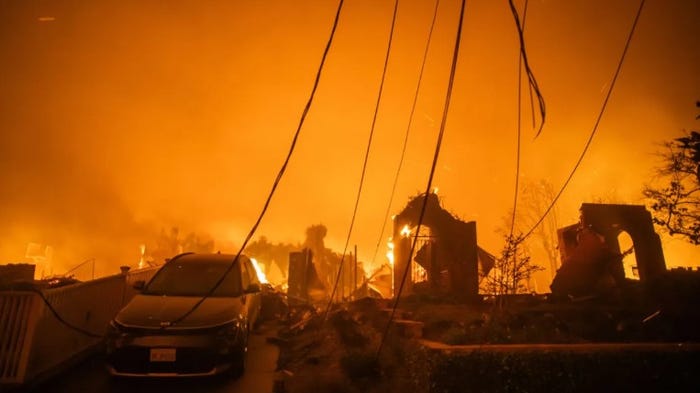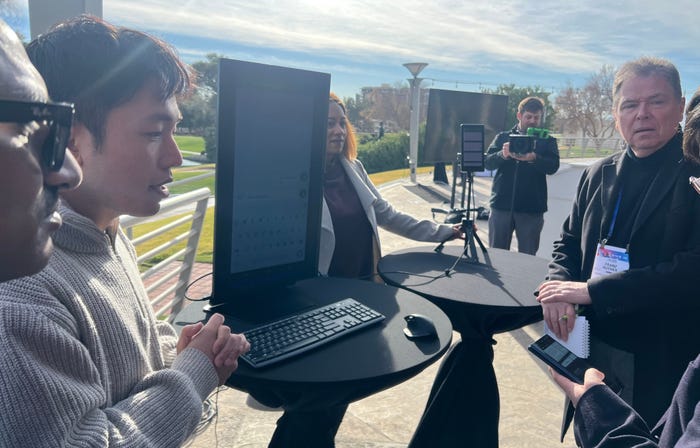When green will make you blueWhen green will make you blue
As buildings become more environmentally friendly, they create substantial headaches for radio-frequency engineers.
April 1, 2011

The use of energy-efficient materials in the construction of new buildings and the renovation of older buildings has negatively affected radio performance in such buildings. This article will explain why this is occurring and what can be done to correct this problem.
A new building complex was planned and one of the local radio shops in the North Texas area had hired us to design a new radio system to provide good radio coverage for the complex owner’s engineering and security departments. The complex consisted of two large buildings totaling 1.5 million square feet and a 1-million-square-foot parking garage on the same campus. The larger of the two buildings is 15 stories, while the smaller is seven stories and stands across a courtyard approximately 100 yards away.
The original design of the radio system called for providing two repeaters, combining the transmitters together, using a duplexer and a receiver multicoupler, and then placing ¼-wave low-profile antennas at strategic locations inside the two buildings. We then used plenum-rated coaxial cable in the data cable troughs used throughout the complex and placed the antennas in the 15-story building to be close to the windows facing the 7-story building. A separate antenna was to be placed on the third floor to provide good line-of-sight to the parking structure.
The antenna system consisted of a series of signal tap-offs and splitters such that sufficient signal was provided throughout the complex. Finally, the first floor of the smaller building had a coaxial line going to the antenna in that building, while floors two through seven would use the five antennas placed in the 15-story building as the primary path back to the repeater equipment for the 7-story building.
Once the building was far enough along in the construction process that the elevators were installed and operational, a temporary repeater was installed on various floors of the main building and the optimum locations were chosen for the antennas to provide good coverage to both buildings.
When we went back to the building after the windows were installed, we were shocked to find that the smaller building had poor coverage to no coverage, because we had great coverage before the windows were installed. This problem caused us to have to redesign the entire system and recalculate the levels needed at each splitter and power divider.
After we determined that the windows were causing problems with our radio system, we also noticed that other radio systems in the VHF, UHF and 800/900 MHz bands were affected. To make matters worse, we had terrible cellular and PCS radio telephone coverage.
In order to provide the required coverage for the building owner, we redesigned the system, pumped more power to the smaller building, and added antennas on every floor of the 7-story building. As a result, we successfully provided the required coverage for the newly designed system. Meanwhile, the public-safety 800 MHz trunking system that the municipality operates has a radio site less than a mile away, so the signal had no problem penetrating the new buildings. But had their repeater site been farther away, the story would have been different.
In order to understand the impact of the signal loss caused by these new energy-efficient windows, we need to first understand what attenuation is and how the numbers impact the systems.
Let’s start by examining decibels, or dB, which can be a ratio of numbers or they can be absolute levels. The way that you use them defines what they are.
The basic formula for dB when used as a ratio or difference between two signal levels is:
dB=10xLOG (Pout / Pin)
dB=20xLOG (Vout / Vin)
The use of dBs as an absolute level is based on:
0 dBm=1 milliwatt (50-ohm impedance)
+30 dBm=1 watt
+50 dBm=100 watts
If the dB label has the letter m, w or K after it, then you are working with an absolute value. If one of those letters is not present, then you are working with a ratio of values.
In order for a radio to work properly and to account for extra losses from body shielding and other obstructions, you normally want your signal level to be at –90 dBm or better at street level.
Now let’s examine other important considerations.
Inverse square law. Simply put, as you double your distance from the transmitter, your signal strength goes down by ¼. If you triple your distance from a transmitter, your signal is now 1/9 of what it was.
Attenuation is the diminishing of signal strength caused by a combination of distance between the transmitter and the receiver (free-space path loss), and obstructions through which the signal must pass. The formula for determining the level of free-space-path-loss attenuation is:
Attenuation=36.6 + 20(Log[Distance in miles]) + 20(Log[Frequency in MHz])
Attenuation also can be measured or approximated depending upon the material, size or shape of the obstruction.
Once we discovered that the signal from the larger donor building was not getting to the receptor smaller building, we knew that we needed to know the exact loss of the signal as it passed through the low efficiency glass. In researching this phenomenon on the Internet, we could not find a single article that addressed it. It was this lack of information that inspired us to write this article, so that others would have a reference tool should they encounter similar problems.
Direct test. We found a door on the ground floor that had the same low-efficiency glass that was used to make the windows. This allowed us to devise a test to determine how much attenuation was being introduced into the radio path by the windows, which were coated with a thin film that was designed to keep out the heat of the summer and the cold of the winter.
A 5-watt UHF portable radio was programmed and keyed up just outside of the building. The signal strength was measured at exactly three feet away using a high-quality communications service monitor (CSM) just inside the building, but the door was open for the reference level directly between the two units. We then closed the door and measured the signal level. The difference represents attenuation between the transmitter and the CSM introduced by the low-efficiency glass.
When the door was open and the signal was measured, it was a +6 dBm. The door was then closed. With the low-efficiency glass between the transmitter and the CSM, the signal was a –23 dBm. This is a loss of 29 dB through the glass; in other words, the low-efficiency glass blocked 99.8% of the signal. We then took the CSM to other parts of the building and found that the signals on VHF, UHF and 800 MHz were attenuated by a similar amount.
Acceptable signal levels. Because the purpose of a radio system is to allow communications from a transmitter unit to be received by others, especially to the dispatcher, there must be enough RF signal to reach from the transmitter unit to the receiver unit. This is true, whether it is from one portable unit to another portable unit, or from a mobile or portable unit to the base station. As attenuation between the transmitter and the receiver increases, at some point you will not have enough signal strength for reliable communications.
Minimum sensitivity. Most radios on the market today have a sensitivity in the 0.35 uV (–120 dBm) range or better. This is the minimum signal level at which the receiver still will work reliably. Most portable radios have transmitter power in the 2- to 7-watt range. As design engineers build public-safety radio system infrastructure, they strive for a coverage area in which the signal level on the street is –80 dBm or better, regardless of where the portables are in relation to the base transmitters. The base receivers are set so that the signal from portable radios can be heard anywhere in their jurisdiction, including inside buildings.
The effect of objects. A radio signal will be attenuated by trees, bushes, buildings, metal objects and anything else that is between the transmitter and receiver units, including the body of a person who is using a portable radio. Most systems have a coverage margin of at least 25 dB. A building made of wood or brick will only attenuate the signal by 10 to 15 dB, while a large building with normal windows will have a 10 to 20 dB attenuation factor. But a building with low-efficiency glass will have an attenuation factor of 30 to 40 dB.
The effect of shortened antennas. Many portable-radio users will object to antennas that poke them in the ribs or even armpits, so they purchase and install shorter antennas onto the portable radios. In most cases, the signal will be decreased by a factor of 2 to 10 dB, which in non-technical terms would be mean 40% to 90% less signal. In most situations, this would not be a problem. The lower signals from these radios only would be a problem when they are used inside of buildings, especially those with higher-than-expected signal attenuation.
There are solutions for radio systems whose users must have communications inside of buildings. These include the use of bidirectional amplifier (BDA) systems within the buildings and vehicular repeaters outside of them. Also direct channels can be utilized to ensure that the communications path is from the building interior to the mobile units parked just outside of the building.
Bidirectional amplifiers can be added to most buildings. BDAs will take the radio signal from a donor antenna on the roof of the building, amplify it and — using coaxial cable or using fiber-optic converters — distribute the signals throughout the building to areas that would otherwise be unable to receive the radio signal. In addition, there will be amplifiers for the return path so that the signals from transmitters within the building will be transported back to the antenna on the roof for reception by the building’s primary radio system.
There are many caveats to using these types of systems. One is that high-quality amplifiers should be used in order to avoid introducing noise onto the channels being amplified. In addition, these systems should not be allowed to oscillate, and they should only be used to amplify specific channels or frequency bands. Finally, they must have their own uninterruptible power source, as a fire or other emergency will cause the primary power in the building to be seriously affected — of course, such emergency situations are when the BDA system is most needed.
It should be noted that many communities have enacted ordinances that require new buildings to provide BDA systems for public-safety radio users within the jurisdiction of those agencies. This allows the governmental agencies to have radio coverage in these new buildings, and the owner of the building has to pay for the system.
Vehicular repeaters. Many public-safety agencies will utilize repeaters installed in patrol cars, fire trucks or command vehicles, so that first responders at a given incident will have good communications. You must have a valid FCC authorization to use this kind of equipment in your system.
Direct channels. Many agencies will have channels programmed into their portable and mobile radios so that they can talk from unit to unit without having to go back to a central repeater system at a given incident. These are sometimes called talk-around or tactical channels, and will provide reliable communications into most buildings from the mobile units parked just outside of the buildings.
As buildings have become more “green,” they also have become less accessible to radio signals. The problem for public-safety personnel is that they will have greatly reduced coverage when they have to respond to an incident within one of these buildings. But by fully understanding these effects and developing a plan for mitigating them in advance of a real emergency, the lack of coverage within these buildings can be overcome.
Ira Wiesenfeld, P.E., is a consulting engineer who has been involved in the radio communications business since 1966. He is a senior member of the IEEE and has been a licensed amateur radio operator since 1963. He can be reached at [email protected].
Dennis A. Riise has been involved with the radio and electronics industries for nearly six decades. He started as an electronics instructor for the U.S. Navy, has worked in avionics and land mobile radio, and has been an amateur radio operator since 1953. He can be reached at [email protected].
Related stories:



